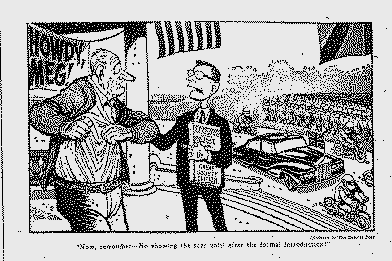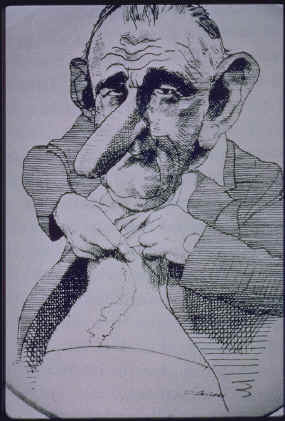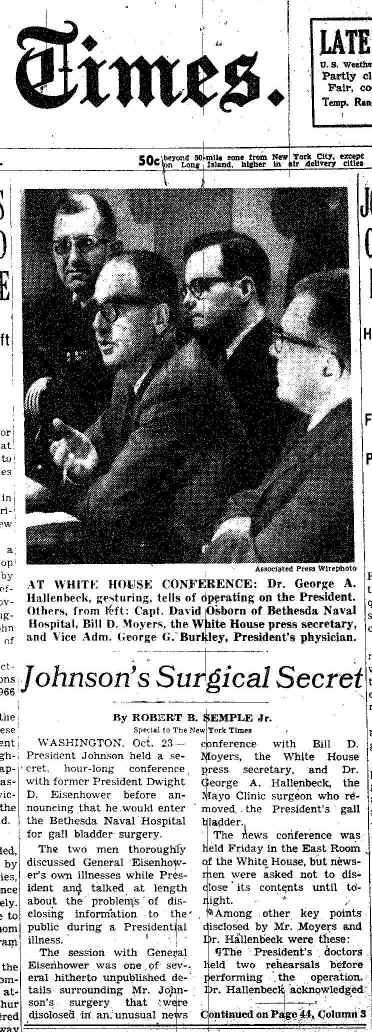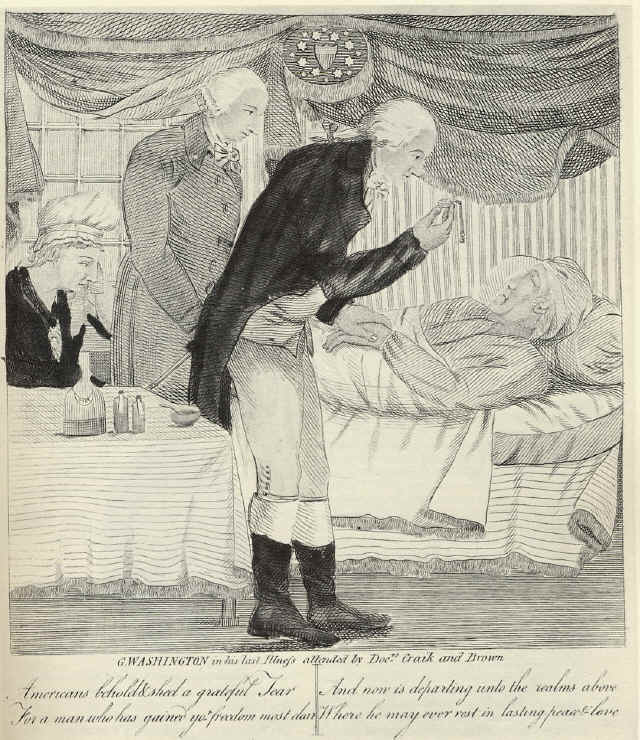NOTE TO READERS: This piece was commissioned by Brill's Content after Vice President Cheney's then most recent heart problems. Due to the "reorganization" and then sudden death of that magazine, it was never published. This is a draft only and could stand some editing and fact-checking; I offer it here on an "as is" basis. Please do not quote or cite without the author's permission and alert him to any errors at PasleyJ@missouri.edu . Print or Web publications interested in the piece (or an updated version) are cordially invited to inquire at the same address. Written during March 2001. Posted May 2001. |
||
| One of the most literally gut-wrenching moments in the annals of presidential press conferences occurred on October 20, 1965. Twelve days earlier, President Lyndon Johnson had undergone a major operation to remove his gall bladder and a stone from his ureter. Unknown to the public and the press, Johnson's doctors had also been concerned about the possibility of more dangerous conditions, such as pancreatic cancer and a recurrence of his earlier heart troubles; true to their fears, the president actually developed a superventicular tachycardia (dangerously accelerated heartbeart) while undergoing anaesthesia. Trying to allay suspicions that Johnson was seriously ill, press secretary Bill Moyers "snowed [the White House press corps] with details," including full-color anatomical slides, and the news media duly carried daily reports of Johnson's convalescence, including such minutiae as how well the president slept on particular nights, Lady Bird planting a tree outside the hospital room window, and his viewing of "Hello, Dolly!" on television. Unfortunately, Moyers had no idea how far the president was willing to take the full disclosure policy. On October 20, Johnson was holding forth to the press as he sunned himself on the Bethesda Naval Hospital grounds. "Apparently feeling words to be inadequate" in describing how he felt, the Baltimore Sun's Muriel Dobbin reported, "the President whipped up his blue knit sport shirt," and, as Time put it, "let the whole world inspect the ugly twelve-inch seam under his right rib cage" where the surgeons had done their work. Many newspapers and both major newsmagazines carried a photo that week of a squatting, squinting LBJ exposing his flesh for the press. | ||
|
|
Though the
reaction was muted compared to what political gaffes produce today among
late-night comedians and cable talking heads, the incident produced a
national snort of derision and embarrassment that quickly reached
Johnson's ears and sent him into a presidential funk . "I didn't
mean to be crude when I showed my incision the other day," Johnson
blurted a few days later to the reporters aboard Air Force One, but then
added to the surfeit of graphic information regarding his body by
explaining that he had merely been illustrating what a heroic job his
doctors had done: "Those fellows had to go through 34 feet of
intestine." Encapsulating Johnson's media image as a shameless,
boorish hick, the scar-showing moment took on iconic status almost
immediately, showing up in editorial cartoons and countless sly
references and becoming perhaps the single best-remembered incident of
LBJ's long political career. Pat Oliphant depicted a shirt-lifting
Johnson being warned by a Moyerseque aide not to show the visiting
Princess Margaret his scar "until after the formal
introduction," and most famously, David Levine portrayed the
president sporting a scar shaped like Vietnam.
This last cartoon is emblematic of the dominant impression one gets when reviewing the news media's handling of Johnson's gallbladder operation and other presidential health crises: While illnesses and operations might seem to provide the most clear-cut opportunities imaginable for "straight" news reporting - what could be more strictly factual than a gallstone - coverage of presidential health problems has tended to be bound up with, and bounded by, the politics of the particular moment in which the president got sick and the perceived popularity of the president in question. |
|
| Coming at a
time when the press corps had clearly grown weary of Johnson's
haphazard, pedal-to-the-metal style, and when unrest over the Vietnam
War was beginning to mount, the gallbladder operation became an early
example of Johnson's as yet unnamed "credibility gap." Despite
providing a "staggering" amount of information in terms of
clinical detail, labeled by columnist Roscoe Drummond "objectively
one of the best reporting jobs in Presidential history," it soon
came out that the Johnson administration had concealed key aspects of
the situation. At a post-release news conference, Johnson's doctors and
press secretary revealed several facts that contrasted sharply with the
president's typically over-the-top efforts to prove that there
was no emergency, such as vigorously
circumnavigating the White House lawn with reporters in tow and signing
copious amounts of legislation in his hospital bed. Among these were: the doctors' concerns for Johnson's
heart and their elaborate preparations to deal with it; a secret meeting
with former president Eisenhower just before the operation, seeking
advice on how to spin the crisis based on the experience of Ike's 1955
heart attack; and the fact that Johnson had been often been sedated,
even long after the operation, something that the administration had
previously denied. A front page story in the Sunday New York Times
carried the headline "Johnson's Surgical Secret," under a
photograph of Moyers and the doctors trying to explain themselves.
Drummond's comment that such detailed information should not be
"packaged in organized optimism" presaged the not yet fully
constructed indictment of the Johnson administration's p.r. efforts in
Vietnam, in which reporters were provided with massive amounts of
technical information on body counts, bombing halts, and the like, only
to have much of it turn out to be fundamentally dishonest and fatally
overoptimistic.
While Johnson's gallbladder operation was probably the first example of a presidential health crisis conducted according to the head-to-toe saturation methods of modern news reporting, the origins of the problems that Johnson ran into by showing his scar date back to well before the founding of the republic. The president fulfills the ceremonial role of a king in our national state and the king's body was one of the most important symbols around which loyalty to the new nation-states were built. In the heyday of the "divine right of kings," when monarchs were conceived by some to derive their powers directly from God, the bodies of the English and French kings were popularly believed to have healing powers; the "royal touch" was sought by thousands to cure certain diseases. Even by the mid-18th century, when Great Britain had a securely constitutional monarchy and the Enlightenment was in full swing, interest in the king's bodily state was high, and it was often identified with the national state, most revoltingly in James Gillray's cartoon of George III as a map of Great Britain defecating ships onto revolutionary France. The problem always was and continues to be how much of the king's body to reveal. Show too much of yourself, as Lyndon Johnson discovered, and the mystique of power evaporates. As the literal embodiment of the nation, he had to be a personage whose power was revered but who could also be loved, like an idealized father in the traditional patriarchal family. Yale historian Linda Colley finds it a sign of disrespect that the Gentleman's Magazine ran a color illustration of George II's dissected heart, but also argues that the mental collapse of George III, probably the first health crisis of a national leader anywhere to be extensively covered by the press, actually helped cement his status as the most beloved British monarch of the period. Illnesses and horrifying medical treatments (seen by modern moviegoers in "The Madness of King George") humanized the king, and the government he embodied, to the point where common people could begin to develop some genuine feelings for him, and it. |

|
|
|
In America, the tradition of symbolizing the nation in the body of a leader naturally began with our own national father-figure, George Washington. Some wondered how the new national government would ever be obeyed or loved without a king-like, embodying figure, and General Washington was the obvious candidate both for that role and the presidential office that was designed to come as close to a monarch as the American people would allow. Many of the cultural observances once devoted to honoring the king - full-length portraits, equestrian statues, images on tavern signs and household walls, and the celebration of his birthday as a holiday - were shifted to Washington, especially after he became president in 1789. The press was heavily involved in this process, chiefly through the agency of Boston entrepreneur John Fenno, who raised money from wealthy supporters of the new constitution and founded a newspaper, The Gazette of the United States, that was explicitly intended "to endear the GENERAL GOVERNMENT TO THE PEOPLE." Naturally, this meant plenty of copy on Washington, and Fenno's tendency was to dwell on non-policy matters such as the way the president managed his household and the number of girls in white dresses who serenaded him as he entered a city on his travels. Many other newspaper editors and writers came to find these royal displays of Washington less endearing, and increasingly suspected a plot, with Fenno's Gazette as a leading element, to create a full-blown monarchy in the United States. Even such seemingly innocuous matters such as Washington's practice of delivering speeches to Congress personally became controversial - it brought to mind the king reading his speech from the throne at the opening of Parliament - and when Thomas Jefferson stopped making personal appearances before Congress after his first inaugural, the practice was not resurrected again until the administration of Woodrow Wilson. Despite all the attention to Washington's person, there was relatively little in the press about his health while he was president, though he was no slouch when it came to enduring disgusting illnesses and brutal medical treatments. Washington had lost his teeth in middle age and the wooden dentures we all learned about in school were only one example of his dental travails. He had another pair with a steel spring in the back that forced his lips forward into the grim, jut-jawed expression evident in the famous portraits. Basically healthy for his age and era up through the first presidential election, Washington was like many later presidents in becoming suddenly afflicted once he took office. During the first year, a staphylococcus infection in the president's leg produced a large, pus-filled carbuncle that made him desperately ill until a physician finally dared to drain it; then he caught a cold in Boston, apparently launching a minor epidemic of what his enemies called the "Washington Influenza." Finally, in May 1790, a case of pneumonia nearly ended the president's life. The presidential workload was "as much, if not more, than I am able to undergo," Washington wrote, feeling that one more serious illness would surely "put me to sleep with my fathers." Washington's fatalism and pessimism about his health was widely shared in early America, for the very good reason that almost any illness or injury could kill quickly in the days before the medical profession knew about bacteria, and bleeding and purging were cutting-edge treatments. As it happened, the big sleep did not come for Washington until 1799, after his retirement from the presidency. He rode around his plantation in the rain on December 12, complained of a sore throat the next day, and by the following night he had suffocated to death, his airway blocked (modern medical historians believe) by a massively swollen epiglottis. |
||
|
|
||
| Washington's
passing came at a time when the country was on the brink of war with
France, the Alien and Sedition Acts were in effect, and one of the
earliest and bitterest presidential campaigns in history was raging,
with the prospects for a peaceful transfer of power looking dubious at
best. The country needed its reassuring father-figure badly, and thus
Washington's death became the first presidential health crisis to be
heavily reported and commented upon in the press. Nearly every newspaper
carried extensive notice of the death and commemorations, at a time when
reporters in our sense did not exist in America and news
"coverage" itself was strictly accidental. Besides the
newspapers, American printers also published hundreds of books,
pamphlets, and prints on Washington's death. Included in many of the
newspaper reports and other publications were statements from the former
president's three doctors. The youngest of the three physicians, Elisha
Cullen Dick, reported that he had proposed performing a tracheotomy,
then a highly experimental procedure but the only treatment that might
have actually saved Washington by allowing him to breath. Dick was
overruled by his older colleagues (Doctors Craik and Brown), who worried
about trying so wild a scheme in such a high-profile case, and instead
favored, with their patient's support, more bleeding, laxatives, and
emetics. A minor controversy erupted over the doctors' miscues, but,
like Dale Earnhardt fans, most of Washington's admirers preferred to
think of their hero meeting a good, clean demise. A popular print of
Washington's death, said to be the model for myriad later
leaders-on-their-deathbed scenes, featured a tearful Martha and the two
older doctors (one of them checking the time), but left out the pesky
Dr. Dick. The bulk of the published material on Washington's death
concentrated on extolling his character, praising the manful stoicism
with which he expired, and envisioning inspirational scenes of
Washington being lifted into heaven by troops of angels, a scene
featured today on the dome of the U.S. Capitol.
After Washington, it would be many decades before a president or former president's health was extensively covered again, despite numerous presidential illnesses. Though mansions were typically built on hills in those days, for breezes that could keep down insects and slopes that allowed water and sewage to flow freely away, the president's mansion at Washington City was situated on a low, marshy spot near the fetid "Tiber" Creek, despite the region's warm, humid climate. Though no one quite understood the mechanisms, it was quite clear to the various occupants of what came to be called the White House that the place was a potential death trap. Millard Fillmore was so spooked by the spectre of death one hot summer night that he went off to sleep in Georgetown, then an entirely separate place. Numerous presidents and their family members lost their health or lives on Pennsylvania Avenue, and it took a serious diet and exercise nut like John Quincy Adams, whose regimen included long, naked swims in the Potomac, to come out unscathed. Why was this threat to the republic's leaders so rarely mentioned in the press? The speed of death or recovery in most of the cases and the inability of doctors to provide any real information on what was wrong limited the amount of reporting that could be done, but equally important was the somewhat limited role of the president in the 19th-century political system, when Congress, the political parties, and (by some measures) the press itself were far more powerful, relative to the presidency, than they are today. Newspaper editors were typically not just partisan, but actual working politicians themselves, often far more permanently entrenched than presidents who came and went every 4-8 years or less. By their own lights, the old newspaper editors quite naturally and appropriately subordinated their reporting of presidential illnesses to the political needs and interests of their particular party or faction. So, when President James Madison developed a life-threatening case of malaria in June 1813, at the height of the War of 1812, the newspapers responded according to their politics. The Washington National Intelligencer, the unofficial spokes-paper for all three "Virginia Dynasty" administrations (Jefferson, Madison, and Monroe), kept quiet about the president's indisposition for two-and-a-half weeks, until the illness was mentioned on the floor of Congress and the newspaper had to acknowledge it. By this time, the Intelligencer's editors admitted, Madison's condition was already "known to most our readers, from common report," but they had not believed the situation serious enough "to justify our alarming his numerous and devoted friends." The specific nature of the illness was never mentioned, and thereafter the journal contented itself with periodic notices that Madison "continues convalescent," though the July 7 edition did let slip the shocking detail that only just that day, for the first time in almost a month, had the president been able to attend to public business. The war's Federalist opponents were not so kind, either in respecting his privacy or estimating his condition. They publicly revealed the illness long before the Intelligencer and described Madison as either certain to die and "appear before the bar of Immortal Justice" or as primarily afflicted with political hypochondria (what the Maryland Gazette called "the idle phantoms of a distempered imagination"). The war effort was going very badly at this point, with many northern state governments more or less openly resisting, and Madison's standing was at a low ebb. The opposition papers had already built a reputation for Madison as a small, weak man far too timid to fight a war, so his illness was actually made to seem damning. The Senate's decision to investigate Madison's conduct of the war had been "rather too much for the delicate nerves of our Chief Magistrate," wrote the New York Evening Post, while the Georgetown Federal Republican observed that the "ague and fever" of "the little restrictively energetic warrior" came and went with the threat of British attack on Washington. Doubts were also expressed about whether elderly Vice President Elbridge Gerry could handle the job should Madison succumb. Later illnesses of presidents and presidential candidates met with similar patterns of response. One of the most extended controversies took place over the health of Treasury secretary William H. Crawford, the favorite of many prominent Democratic Republican officeholders and editors to succeed James Monroe in 1824. Their plans to anoint Crawford were interrupted in September 1823 when the candidate was severely debilitated by a mysterious illness, possibly a stroke or overdoses of harsh but commonly used medications such as digitalis, laudanum, and calomel (the latter two made of opium and mercury, respectively). Whatever the cause, Crawford spent much of the next 14 months, which covered the entire presidential campaign, nearly blind, barely able to speak, and partially paralyzed. Crawford's supporters went ahead with their campaign anyway, seizing on overly optimistic reports in 1824 that he was recovering. They had him nominated for president by a congressional caucus (the usual method up until that time), but only about one-third of the eligible members showed up. Crawford's health thus became a chief, though partly submerged, issue in the 1824 presidential campaign. Opposition to the congressional caucus was strong by then, and there were at least four other candidates, all Democratic Republicans, being put forward despite the nomination. The most widely read Republican newspapers, including the National Intelligencer and the South's leading journal, the Richmond Enquirer, supported Crawford and tried to ignore or obfuscate his condition, but the rest of the press hinted that he was totally incapacitated or near death. While more space was expended attacking Crawford as the candidate of a corrupt elite of officeholders, anti-Crawford writers and editors found it useful to let hang in the air the idea that these people would stop at nothing, even electing a pathetic shell of a man, in order to keep power and the money that went along with it. The Philadelphia Columbian Observer, which supported Andrew Jackson, opined that Crawford's affliction was but "the retributive justice of Providence" for his corruption. The editor of Niles' Weekly Register, one of the few relatively objective journals of that time, declared that he simply could not learn whether Crawford was healthy or not from all the conflicting reports. A dramatic visual appearance of some kind would surely have been in order, but the state of the political media in 1824 would not allow it: newspapers in this period did not even usually carry drawings of news events. There was no way to show the public an apparently healthy Crawford going about his business. When the general election was over in November, and Crawford had finished third behind Jackson and Adams, the National Intelligencer argued bitterly that Crawford would surely have won had not his health "been misrepresented with the most assiduous industry." When William Henry Harrison sickened and died after only a few weeks in office in 1841, it was again his journalistic opponents who revealed his illness first and made the most dire prognoses. Harrison, a Whig, fell ill on Saturday, March 27, and the Democratic Washington Globe reported it on Monday and declared him in "a very precarious situation" on Thursday, and "dangerously ill" on Friday. The now-Whig National Intelligencer did not mention any problem until Wednesday and found the president "decidedly better" that day, slightly improved on Thursday, and unchanged on Saturday. Contrary to the trend of those reports, Harrison expired on Sunday, April 4, proving the Democrats to be better physicians, at least when they were out of power. Not allowing the death to interrupt his partisan assault on the administration, Globe editor Francis Preston Blair blamed Harrison's death on the Whigs, who had never before held the presidency. The oldest president elected up until that time (something that had been an issue in the campaign), Harrison's supporters "had shown too little consideration . . . for his condition." Office-seekers had waylaid him in the hall before he could get to breakfast and waited outside his bedroom. The "continual whirl of agitation" and constant press of difficult political business generated by the greed of his supporters had been more than Old Tippecanoe "had strength to support." It would be heartening to report to that the characteristic methods of the partisan press in dealing with presidential illness - cover-up, partisan diagnosis, and political exploitation - were abandoned once financial independence and professional reporting became the norm in the early 20th century. Alas, this appears not to be the case. Partly the fault lies with the presidents themselves. The existence of an aggressively information-gathering press corps made presidents even more defensive about their health than before, and the emergence of the United States as a world power made such secrecy even easier to justify. With U.S. foreign policy increasingly predicated on the notion that the president was the "leader of the free world" whose vigilance and resolve would keep aggressors in check and allies in harness around the globe, peace and liberty themselves could seem to depend on the president's apparent vigor. Thus it has been in the 20th century that the most egregious cover-ups of presidential illnesses have occurred, with the press often convinced to play along out of patriotism. So news of Woodrow Wilson's stroke was kept quiet at the end of World War I, as was FDR's near-death status during and after the 1944 election and the seriousness of John F. Kennedy's various afflictions, including his supposedly "non-classic" case of Addison's Disease and back problems so severe that he could not pick up John-John and required highly suspect injections from Max "Dr. Feelgood" Jacobson. (Full knowledge of JFK's health problems would have been very bad for a candidate whose platform was almost based on his alleged youthful vigor.) Nor have the presidents or the press done much better in the cases where floods of information were released but the most serious problems were hidden, including Eisenhower's heart attacks and Reagan's various health problems. In Reagan's time, the media provided such niceties as front-page diagrams of the presidential colon, but missed bigger stories such as the signs of Alzheimer's that probably dated all the way back to his shooting in 1981. Of course, one exception to this last generalization was the president we began with, Lyndon Johnson, who tried obfuscating the truth about his health but received terrible press for it anyway. Relatively weak or unpopular presidents and candidates still tend to get worse reports on their health. Hence one of the early campaign "feeding frenzies" occurred when struggling Democratic candidate George McGovern's running mate, Thomas Eagleton, turned out to have been treated earlier for psychiatric disorders. Likewise, George W. Bush's reputedly low intelligence and lack of a popular majority surely have contributed to Vice President Richard Cheney's image in the current media as a man who could keel over at any moment. Cheney had better suppress any urges to show the press how well he has healed from his latest heart surgery. © 2001 by Jeffrey L. Pasley |
||



